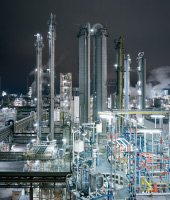Comparing Actual with Forecast Performance
WACKER achieved the goal set at the start of 2014 to increase sales for the reporting year by a mid-single-digit percentage. The EBITDA trend was markedly better than projected in March 2014 and in the 2013 annual report. This improvement stemmed from good business trends at every division, from cost savings, and from advance payments retained and damages received due to the amendment or termination of long-term polysilicon supply contracts.
At WACKER POLYSILICON, solar-silicon prices rose at the start of the second quarter. In Siltronic’s business, there was a significant year-on-year increase in 300 mm silicon-wafer volumes as a result of integrating Siltronic Silicon Wafer Pte. Ltd. into the Group. At the same time, prices for semiconductor wafers were significantly down on a year earlier. In total, they were over 10 percent lower on average than in 2013. In line with expectations, business at our three chemical divisions – WACKER SILICONES, WACKER POLYMERS and WACKER BIOSOLUTIONS – developed positively due to a substantial rise in volumes and positive price effects in specific product segments. Higher personnel expenses and negative exchange-rate effects had an adverse impact. Overall, these three divisions increased their sales. EBITDA was slightly below the prior-year figure. Energy and raw-material cost trends varied. Raw-material costs were slightly higher, while energy costs stayed within expectations. The exchange rates of the US dollar and the yen against the euro developed somewhat more favorably than we had assumed in our projections at the beginning of 2014.
Sales Projections Raised after Second Quarter
With the publication of the Q2 Interim Report in July 2014, WACKER raised its forecasts for EBITDA, EBITDA margin, and ROCE. EBITDA was now expected to rise by at least one-third instead of by at least 10 percent. As for the EBITDA margin and ROCE, WACKER now assumed they would grow strongly (previously, a slight increase had been assumed). Our sales projection remained unchanged. In the Q3 Interim Report, WACKER further specified its forecast. EBITDA for 2014 was predicted to total some € 1 billion. The EBITDA margin would rise to over 20 percent. And for ROCE, WACKER continued to expect strong growth. As was the case in Q2, the sales projection did not change. Group sales in 2014 came in at € 4.83 billion. The WACKER Group’s 2014 EBITDA amounted to € 1,042.3 million, considerably up from the prior-year figure, as expected. As a result of terminated or restructured supply contracts for polysilicon, we posted € 206.3 million in income from advance payments retained and damages received. This income is included in our 2014 EBITDA.
Excluding acquisitions, investments of about € 550 million were forecast for 2014. At € 572.2 million, investments were within our target corridor. The largest share of this sum went toward the ongoing expansion of our polysilicon production facilities.
Comparing Actual with Forecast Performance
| Download XLS |
|
|
|
|||||||||
|
|
Results in 2013 |
Forecast March 2014 |
Forecast July 2014 |
Forecast Oct. 2014 |
Results in 2014 |
|||||
|
|
|
|
|
|
|
|||||
|
Key Financial Performance Indicators |
|
|
|
|
|
|||||
|
EBITDA margin (%) |
15.2 |
Slight increase |
Substantial increase |
Substantial increase to over 20% |
21.6 |
|||||
|
ROCE (%) |
2.2 |
Slight increase |
Substantial increase |
Substantial increase |
8.4 |
|||||
|
EBITDA (€ million) |
678.7 |
At least 10% higher |
At least one-third higher |
Approx. 1,000 |
1,042.3 |
|||||
|
Net cash flow (€ million) |
109.7 |
Balanced net cash flow |
Positive net cash flow |
Markedly positive net cash flow at the prior-year level |
215.7 |
|||||
|
|
|
|
|
|
|
|||||
|
Supplementary Financial Performance Indicators |
|
|
|
|
|
|||||
|
Sales (€ million) |
4,478.9 |
Mid-single-digit % increase |
Mid-single-digit % increase |
Mid-single-digit % increase |
4,826.4 |
|||||
|
Investments (€ million) |
503.7 |
Approx. 550 |
Approx. 550 |
Approx. 550 |
572.2 |
|||||
|
Net financial debt (€ million) |
792.2 |
Increase of between |
Increase of around 300 |
Increase of around 300 |
1,080.6 |
|||||
|
Depreciation (€ million) |
564.4 |
Approx. 600 |
Approx. 600 |
Approx. 600 |
599.0 |
|||||
|
|
|
|
|
|
|
|||||
Net financial debt and net cash flow developed more favorably than expected at the beginning of the year. In March 2014, we had forecast that net financial debt would climb € 300 million to € 400 million by the end of 2014. We adjusted this forecast to about € 300 million in our Q2 Interim Report. In fact, by year-end, net financial debt had risen by € 288.4 million to € 1,080.6 million. In March 2014, we expected net cash flow to be balanced. We revised this estimate in our Q2 report, when we assumed net cash flow would be positive. We once more raised our net cash flow estimate in the Q3 Interim Report and specified it as follows: markedly positive net cash flow at the prior-year level. As of December 31, 2014, net financial debt of € 1,080.6 million and net cash flow of € 215.7 million were both in line with our expectations.
R&D expenditures for the development of future products and solutions amounted to € 183.1 million for full-year 2014, slightly higher than the figure forecast at the beginning of the year. This was due to the consolidation of Siltronic Silicon Wafer Pte. Ltd.
As anticipated at the start of the year, the workforce increased. As of the reporting date, WACKER had 16,703 employees, a year-on-year increase of 694, which was due to the acquisition of Halle-based Scil Proteins Production GmbH and WACKER’s assumption of a majority stake in Siltronic Silicon Wafer Pte. Ltd.
The Executive and Supervisory Boards will propose a dividend of € 1.50 per share for 2014 (dividend for 2013: € 0.50) at this year’s Annual Shareholders’ Meeting.
Deviations from Projected Expenses
Personnel expenses rose year on year, both in absolute terms and relative to sales. They increased about 10 percent in absolute figures. We were slightly below the 2014 target figure. The rise in personnel expenses is due to changes in the scope of consolidation and to non-recurring payments relating to the company’s centennial. As a result of the acquisition of the majority stake in Siltronic Silicon Wafer Pte. Ltd. and of Scil Proteins Production GmbH, the personnel expenses of these companies were recognized in our figures for the first time in 2014. They are also the main reason for the increase in employee numbers. Over the medium term, we expect personnel expenses – excluding non-recurring effects – to account for about 25 percent of sales.
In absolute terms, raw-material costs fell slightly against the prior year; relative to sales, the year-on-year decline was considerable. A more favorable product mix and our programs to reduce raw-material consumption in our products had a positive impact. Conversely, raw-material price trends varied, with the price of vinyl acetate monomer, in particular, rising substantially during Q2. We were below our target for 2014 by more than one percentage point. In the medium term, we expect raw-material costs to remain flat relative to sales.
Energy costs, too, came in below our target, due to more favorable procurement conditions and a lower regulatory cost burden.
Depreciation in absolute terms was both well above the prior-year level and above our target. This was particularly due to the acquisition of the majority stake in Siltronic Silicon Wafer Pte. Ltd., as a result of which this company’s depreciation was fully included in our figures. The 2014 target figure had not taken full account of this depreciation. In total, our depreciation amounted to € 599 million, with some 39 percent of this sum being accounted for by our polysilicon facilities. Depreciation will rise further in the medium term owing to our investments in polysilicon-capacity expansion.
Expenses by Cost Types
| Download XLS |
|
|
||||||
|
% of sales |
2013 |
Target 2014 |
Reported 2014 |
|||
|
|
|
|
|
|||
|
Personnel expenses |
25.3 |
26.3 |
26.2 |
|||
|
Raw-material costs |
28.2 |
27.4 |
25.5 |
|||
|
Energy costs |
10.2 |
9.4 |
8.8 |
|||
|
Depreciation |
12.6 |
12.0 |
12.4 |
|||



